Stretching Basics
September 24th, 2015 by Do It Tennis
.jpg) For many athletes, stretching is key to injury prevention and can be the difference between dealing with nagging injuries and playing with a sense of physical “freedom”. There are many perks to stretching. An important and obvious one is increased flexibility, which can improve your performance. A second important, maybe less obvious, benefit is it can also help cut back on muscle soreness/tightness which allows you to focus on your match and not how sore you feel from the day before.
For many athletes, stretching is key to injury prevention and can be the difference between dealing with nagging injuries and playing with a sense of physical “freedom”. There are many perks to stretching. An important and obvious one is increased flexibility, which can improve your performance. A second important, maybe less obvious, benefit is it can also help cut back on muscle soreness/tightness which allows you to focus on your match and not how sore you feel from the day before.
Different Types of Stretching
Active: Active stretching is when you hold a stretch position for 30-60 seconds. This is the most common type of stretching and is a safe way to improve flexibility. Passive: Passive stretching is where you use an object to help you stretch such as a curb or a wall. For the most part, the object can do most the work. This is a good way to stretch if you have a limited range of flexibility and/or an injury that hinders you from effectively stretching on your own. Dynamic: Dynamic stretching is when you use momentum. In other words, it’s moving while you stretch, such as leg swings and arm circles. These make great warm-ups as they get your muscles warm and loose. Assistive devices: There are many assistive devices that you can use for stretching, as well. One of the more popular of these are bands, which come in various tensions. You can use them to stretch further than you would have been able to on your own.Tips for Stretching
• Don’t stretch cold muscles: This can cause a quick injury. Do a warm-up, like a fast walk or jog, before you start your stretches. Warm muscles are easier to move and stretch than cold muscles. • Hold your stretch for at least 30 seconds: To get the fullest benefit of a stretch, you should be holding it for at least 30 seconds. Of course, when you advance more and more try to hold it a little longer. If it is painful at all, don’t force it. Instead, lower the time you hold the stretch for and work up to the 30 seconds. • You shouldn’t feel (too much) pain: The point of stretching is to prevent pain, not cause it. It will be a little uncomfortable, as you push your muscles to their limits; you should feel a little tug or squeeze here and there, but you shouldn’t feel actual pain. If you do feel pain, simply go back to the point where you didn’t, and then hold the position. • Make stretching a routine: Add it into your regular workout or regimen. It’s important to be consistent with your stretching to increase flexibility, even if it’s just a few times per week.Tennis-Specific Stretches
Now, as a tennis player, it would also be beneficial to add tennis-specific stretches to your routine in order to help prevent muscle fatigue or pain while you’re playing, and to improve recovery time afterwards. Naturally, tennis-specific stretches account for what are the most used parts of the body while playing tennis. Here are some tennis-specific stretches you can try out the next time you hit the court: Wrist stretch: Stretch your wrist with your palm facing out, and then with your palm facing in.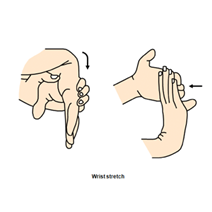 Shoulder stretch: Stretch your shoulder by reaching your arm across your chest and holding it against the opposite shoulder.
Shoulder stretch: Stretch your shoulder by reaching your arm across your chest and holding it against the opposite shoulder.
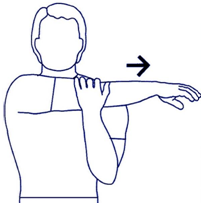 Tricep stretch: Bend your elbow behind your head like you are reaching for the middle of your back. Gently push down on that bent elbow.
Tricep stretch: Bend your elbow behind your head like you are reaching for the middle of your back. Gently push down on that bent elbow.
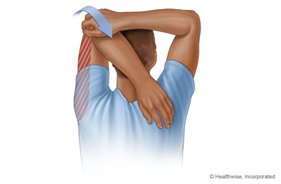 Hamstring stretch (with rope): Lay on your back and lift one leg up in the air so the bottom of your tennis shoe is facing flat towards the sky. Loop a strap, rope or stretching band around the ball of your foot and use it to pull your leg towards your body until you feel a stretch, and hold it. Your leg actually should not be perfectly straight, but you should also minimize the bend depending on your personal flexibility. Note the man’s leg in the image to see an appropriate bend for this stretch. You could also easily use a belt for this stretch.
Hamstring stretch (with rope): Lay on your back and lift one leg up in the air so the bottom of your tennis shoe is facing flat towards the sky. Loop a strap, rope or stretching band around the ball of your foot and use it to pull your leg towards your body until you feel a stretch, and hold it. Your leg actually should not be perfectly straight, but you should also minimize the bend depending on your personal flexibility. Note the man’s leg in the image to see an appropriate bend for this stretch. You could also easily use a belt for this stretch.
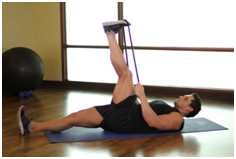 Figure 4 stretch: Lay on your back with both knees bent and feet on the ground. Pick up one leg and place the ankle of that leg at the mid-thigh of the other leg, making a 4. For some people, that will be enough of a stretch. If you do need to go deeper to feel the stretch, grab the hamstring of the leg still on the ground, and pull it towards your chest while still in the figure 4 position, and hold it.
Figure 4 stretch: Lay on your back with both knees bent and feet on the ground. Pick up one leg and place the ankle of that leg at the mid-thigh of the other leg, making a 4. For some people, that will be enough of a stretch. If you do need to go deeper to feel the stretch, grab the hamstring of the leg still on the ground, and pull it towards your chest while still in the figure 4 position, and hold it.
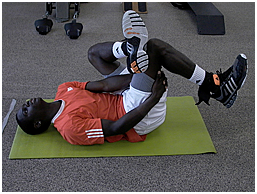 Now that you know (or have been reminded of) the stretching basics you can put these tips techniques into action, no matter what physical activity you’re about to begin. If you’re going to hit the tennis court, or just get done playing, we recommend trying the tennis-specific stretches above.
Now that you know (or have been reminded of) the stretching basics you can put these tips techniques into action, no matter what physical activity you’re about to begin. If you’re going to hit the tennis court, or just get done playing, we recommend trying the tennis-specific stretches above.


